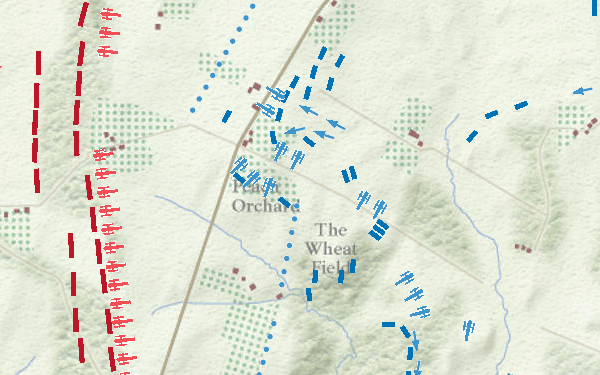Weatherman2020
Diamond Member
While Lee nor any of his Generals clearly stated what their objective was for invading Pennsylvania, my feeling was Lee wanted to bring the horrors of war to the doorsteps of Northerners in order to get people elected who were willing to let the South succeed from the Union.
But for whatever reason Lee’s Army is now confronting the Union Army in Gettysburg PA. The first of three days of the battle went fairly well for Lee, but while they had pushed the Union Army back they failed to take the high ground at Culp’s hill and Cemetery ridge. Day two Lee attacked both flanks which failed.
Day three Lee incorrectly thinks the Union center is weak because the flanks are well defended. Meade had played a hunch correctly and built up the center overnight. So Lee orders a frontal assault across a mile of open field despite witnessing what his outnumbered men did to Union forces at Fredericksburg over a shorter field just the year prior.

This is from Lee’s position, the arrow points to the copse of trees Pickett’s 13,000 men were to go towards and break thru the Union line. To add to the mile of open field are three well built fences his men must navigate.

This is from the Union position at the only point Pickett’s men reached - the high watermark of the Confederacy. Pickett started in the line of trees in the distance.

The assault began with the largest artillery attack ever to take place on this hemisphere. Approximately 170 cannons fired for almost two hours to soften up the Union line. People in Baltimore heard what sounded like distant thunder.

Initially Union artillery returned fire. But gunpowder smoke had obscured the view of the Confederacy and most of their shells were going over the Union line. Seeing this the Union commander of the artillery ordered his cannons into silence so the Confederates would think they had been taken out. It worked. Pickett’s men moved forward.
This is the field of fire of the Union artillery during Pickett’s charge. The red circle is the copse of trees Pickett was to head towards.

It was murder. That’s about all you can say. The Confederacy was over at this point. But like all wars they go on long after it’s over just delaying the inevitable and costing many lives and the further destruction of infrastructure of the losing side. Lee retreats back to Virginia and conducts a series of battles to defend Richmond.
But for whatever reason Lee’s Army is now confronting the Union Army in Gettysburg PA. The first of three days of the battle went fairly well for Lee, but while they had pushed the Union Army back they failed to take the high ground at Culp’s hill and Cemetery ridge. Day two Lee attacked both flanks which failed.
Day three Lee incorrectly thinks the Union center is weak because the flanks are well defended. Meade had played a hunch correctly and built up the center overnight. So Lee orders a frontal assault across a mile of open field despite witnessing what his outnumbered men did to Union forces at Fredericksburg over a shorter field just the year prior.
This is from Lee’s position, the arrow points to the copse of trees Pickett’s 13,000 men were to go towards and break thru the Union line. To add to the mile of open field are three well built fences his men must navigate.
This is from the Union position at the only point Pickett’s men reached - the high watermark of the Confederacy. Pickett started in the line of trees in the distance.
The assault began with the largest artillery attack ever to take place on this hemisphere. Approximately 170 cannons fired for almost two hours to soften up the Union line. People in Baltimore heard what sounded like distant thunder.
Initially Union artillery returned fire. But gunpowder smoke had obscured the view of the Confederacy and most of their shells were going over the Union line. Seeing this the Union commander of the artillery ordered his cannons into silence so the Confederates would think they had been taken out. It worked. Pickett’s men moved forward.
This is the field of fire of the Union artillery during Pickett’s charge. The red circle is the copse of trees Pickett was to head towards.
It was murder. That’s about all you can say. The Confederacy was over at this point. But like all wars they go on long after it’s over just delaying the inevitable and costing many lives and the further destruction of infrastructure of the losing side. Lee retreats back to Virginia and conducts a series of battles to defend Richmond.
Last edited:

